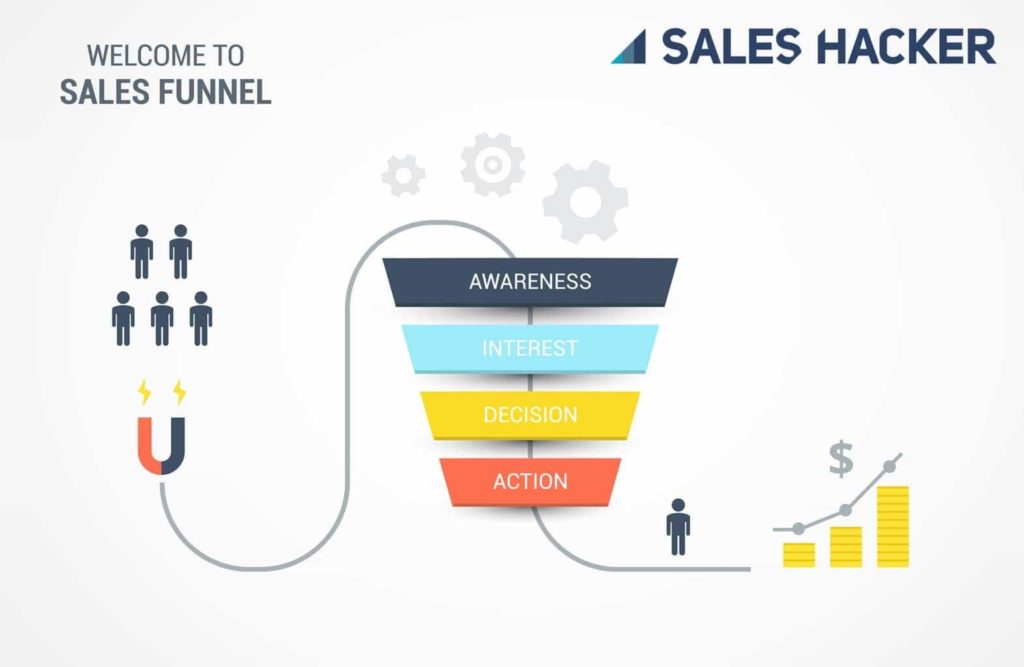Sales pipeline management is at the core of everything we do in sales. Mastering the sales pipeline is a core way to increase revenue because it allows sales reps to remain organized and focused on selling.
I’ve been helping sales teams reach their full potential since 2013. This article is everything I know to be true about sales pipeline management — including my personal 6 best practices.
Table of contents
- What is a sales pipeline?
- Sales pipeline vs. sales funnel
- 7 stages of a sales pipeline
- How to build a sales pipeline
- What is sales pipeline management?
- 6 best practices for sales pipeline management
What is a sales pipeline?
A sales pipeline is a way of visualizing where potential customers (prospects) are in your sales funnel. The sales pipeline allows you to organize, track, and manage sales activities, information, and other signals key to generating predictable, efficient, and effective revenue.
Hold up: Sales pipeline vs. sales funnel
You may hear people use “sales pipeline” and “sales funnel” interchangeably — but these terms have separate meanings.

Sales funnel
Sales funnel and sales pipeline are pretty similar at first glance. Here’s a quick way to tell them apart:
The sales funnel represents the journey from prospect to customer from the prospect’s point of view.
The sales funnel follows the traditional buyer’s journey, with four stages: awareness, interest, decision, and action (usually purchase or opt-out). As you can see in the graphic above, this also reflects the conversion rate at each stage of the process — many B2B customers enter the funnel at the awareness stage; relatively few emerge as customers at the end.
(For a deeper dive into the sales funnel, check out this great guide from Outreach, What Is a Sales Funnel?)
Sales pipeline
Okay — so remember how the funnel represents the prospect’s point of view?
The sales pipeline reflects the seller’s point of view.
A sales pipeline outlines the stages a prospect goes through as they go from lead to customer, from your point of view. It consists of seven basic pipeline stages, and is organized by what your team needs to do at each stage:
Sales pipeline stages
Prospecting (lead generation)
Your marketing team (which may or may not include sales development representatives and other outbound sellers) attract and engage prospects using marketing campaigns, targeted ads, and capture of client information such as name and email address.
(If your sales and marketing teams aren’t in lockstep yet, read 6 Roadblocks and Solutions for Better Sales and Marketing Alignment )
Lead nurturing
Involves follow-up on leads by maintaining a channel of communication between you, the salesperson, and the lead. The process involves offering the prospect relevant information, mostly done via email.
Bonus: Check out this framework for writing follow-up emails buyers can’t wait to share
Marketing Qualified Lead (MQL)
This is a lead who has met set criteria by the marketing team and is ready to be passed onto the SDR or XDR team.
Challenge to industry wisdom: Improve Your Pipeline: Let Sales Control the Flow of MQLs
Sales Accepted Lead (SAL)
A sales accepted lead is one who has met the set criteria by the outbound sales team and is ready to be passed along to the account executives and inbound sales team to work the opportunity.
Sales Qualified Lead (SQL)
A sales qualified lead represents a lead that has been vetted by a sales team and been deemed a potential customer.
Closed deal
This is a potential customer who makes a purchase and converts it into revenue.
Post-sale
It’s a collection of processes that occur after a closing sale with a customer. Post-sale includes billing and collections, returns, complaints, and customer support.
How to build a sales pipeline
Okay: Now that we’re on the same page, I’ll shift focus to how to build a sales pipeline. The process can be summarized into six steps.
1. Take stock of your prospective buyers and identify your target market
By identifying your Ideal Customer Profile, ICP, you get a rough estimate of how many customers your business will be able to cater to. The ICP is usually updated after a year for companies younger than three years.
The CEO, founding team, and other C-level executives are responsible for creating and updating the Target market and Ideal Customer Profile.
Bonus: What the Frack: How to Mine Your (Sales) Pipeline and Break Into New Markets in 3 Easy Steps
2. Identify your target companies
Target companies include corporations you intend to conduct business with and are derived from your ICP. The Company CEO, Chief Revenue Officer, and sometimes the Vice President of Sales usually preside over this process.
Bonus: 4 Surprising Places to Find Warm Leads
3. Do your research
Work through target contacts and create an internal list of target companies based on your ICP. Here are a few tips for optimizing this process.
- Find the names of your target contacts.
- Enrich those contacts with additional information such as email addresses or phone numbers.
- Conduct a bit more research to find out more personal information on both the person and the company.
There are two approaches to this process:
Buy the list: It comes with names, contact information, and other personalized details. This is the path of least resistance, but beware of list quality. Many lists are of poor quality, and even if the list vendors are diligent in keeping it up to date, quality declines very quickly as people change jobs, positions, or companies, taking their contact information with them.
Build the list: This involves the painstaking process which means manually looking for names and more personal information. This is the best way to ensure highest list quality — even if it takes more work.
Related: How to Build a Sales Pipeline That Always Packs Hot Deals
4. Reach out to your targets
Includes channels of communications such as email, direct email, and even physical meetings.
Prospecting is way too big a subject to get into here. For a great exploration of the topic, check out Sam McKenna’s article The Definitive Guide to Sales Prospecting With Proven Outreach Methods , or Rex Biberston’s 9 Cold Calling Tips & Techniques To Help You Win Big .
5. Find a routine
Divide your pipeline into segments by focusing on value-based selling.
Make sure your sales representatives are good communicators, building authentic human relationships. (I highly recommend David Fischer’s article, How to Build Rapport in Sales Calls, With Do’s and Don’ts.)
6. Build momentum as you progress further down the funnel
By moving your Sales Qualified Leads over to the Account Executive, you increase momentum and helps you meet your goals and stay true to your objectives. The Account Executive is charged with the role of following up with and evaluating a lead until it’s a closed or lost deal — which symbolizes the end of the sales process.
What is sales pipeline management?
Sales pipeline management is the organization and tracking of prospects, goals, and quota. It also includes understanding whether certain deals need special attention.
Effective pipeline management allows salespeople to keep track of deals by knowing exactly which stage the deal is in, and whether there are enough deals on the board to hit goals and quota.
Characteristics of sales pipeline management
Before delving into the concept of pipeline management, we must first understand what makes up a sales pipeline. The first is metrics, which involves data collected regarding the sales pipeline that can be used to analyze your sales process.
Related: The SaaS Metrics Blueprint: How to Define, Measure, and Display What Matters
Next, there’s optimization. A well-managed sales pipeline enables you to evaluate and optimize your process at every stage, assuring you increased revenue at the end of a sales cycle. As part of the pipeline management, sales forecasting is the process of predicting sales revenue and ways to increase it.
Sales team management also involves regular progress tracking and evaluations of your sales personnel. This is achieved by gathering vital information such as when and how your team makes the most of the sales process.
Finally, pipeline management tools and applications are designed to increase revenue and improve the performance of your pipeline and your sales team.
6 best practices for sales pipeline management
1. Track your sales metrics

Mastering the sales pipeline is all about understanding the numbers and components of the sales funnel. If sales managers know the averages they are able to better predict and create predictable revenue.
Here are the metrics you must track to manage your sales pipeline:
- New leads created per month by source
- Conversion rate of leads to opportunities
- Conversion rate of opportunities to closed deals
- Average won deal size
- Average sales cycle length
- Win rate
- Total # of open opportunities
Additional metrics may also include:
- Value of leads
- Deal close rate
- Sales pipeline velocity
Let’s look at an example using the Pipeline Velocity metric. This formula can be interpreted as dollars earned per day by the sales team. The key point with pipeline velocity is to focus on each input not the final output metric.
The equation for pipeline velocity is:

There are four components of pipeline velocity: open opportunities, average deal size, win rate, and average sales cycle.
Each of these components is a lever that can be pulled to impact business results. This example illustrates how each of these metrics affects pipeline velocity:

Pipeline velocity is just one key sales metric. For a deeper dive into sales metrics, read: Sales Metrics: When, How & Why To Track Them
2. Execute regular pipeline reviews
Every sales manager conducts regular forecast meetings. Unfortunately, like most things in sales, forecast meetings only focus on opportunities that are expected to close by the following week — so you need pipeline reviews.
Pipeline reviews focus on opportunities that are at the top and in the middle of the funnel, and are an excellent opportunity to eliminate weak sales opportunities. In pipeline reviews:
- Sales teams can review the quality of opportunities recently added to the funnel
- Managers can have a greater influence on the outcome because these are newer opportunities
- Sales reps and managers have a more comprehensive view of the entire pipeline
For a deeper dive, check out: How to Conduct Killer Pipeline Reviews for Your Salespeople
3. Focus on small improvements at each stage of the sales funnel
Sales is a numbers game, and teams using a predictable revenue system have high volumes of leads to take advantage of. This can causes reps to focus less on quality opportunities.
Limited focus on quality opportunities can be detrimental to your sales pipeline. Small improvements in pipeline management by funnel stage can lead to some promising results.
For example, if reps increase conversion rates by 5% in 2 macro funnel stages, there is a potential 50% increase in the number of won deals.
Learn more about the sales funnel: 7 Key Elements of a High-Performing Sales Funnel
4. Keep that sales pipeline clean
Just like with a marketing funnel, a sales funnel must be optimized and measured. The evolution of the SaaS sales stack is making sales more like marketing each day. Know the apps, know the funnel metrics, and keep an eye on the pipeline conversion funnel.
Pipeline reviews and a solid grasp of pipeline best practices are your best friend here. Here’s an example of a tactic to keep your pipeline clean:
1. Identify cold leads
Evaluate your pipeline velocity metrics to identify leads where you have taken more time than average at specific stages.
2. Decide on a course of action
This process involves deciding whether or not to remove inactive leads.
3. Follow up and re-evaluate
Before permanently removing a lead, conduct a re-evaluation either by email, to establish if they are worth following up in future.
Staying alert to under-performing metrics helps identify areas where your progress is stagnant and learn how to improve.
5. Create a formalized pipeline management operations manual
Got your pipeline management techniques down? It’s time to formalize and scale. Don’t sweat the up-front work: This effort will pay off in greater efficiency for your team, as well as other teams in your org (and the teams to come after you move on to a new company).
Need inspiration? Create case studies of specific opportunities from open to close. Give reps scripts and specific activities to do at each stage of the funnel. Ask yourself:
- What does the buyer journey look like?
- If an opportunity gets stuck in a specific stage what is the rep supposed to do? What has worked in the past?
- What is the average conversion rate by each funnel stage?
Then hop to creating that documentation. If you’ve got sales enablement resources, lean on them — this is where they’ll shine.
6. Use sales enablement content for each stage your prospects go through
This involves providing your leads with additional information beyond the usual phone calls and emails. Consider your sales funnel and what type of information is provided at every stage.
At the top of the funnel, salespeople communicate with their leads through blogs, articles, and infographics, designed to capture their interest. You want your prospect to understand what exactly you bring to the table and how it will benefit them, but packaging the information in a fun and entertaining way.
In the middle of the funnel, sales personnel nurture leads by providing additional information via ebooks, case studies, and video tutorials. The goal is to transform the lead into a paying customer.
The bottom of the funnel consists of the action stage, where the prospect is now officially a paying customer. Salespeople at this level, conduct evaluations and further follow up so that the one-time customer becomes a long-lasting one.
Want more on sales enablement? Read: Sales Enablement: What It Is, Why It Matters, and How to Do It Right
 Updated by Kendra Fortmeyer @ Sales Hacker 2022
Updated by Kendra Fortmeyer @ Sales Hacker 2022




